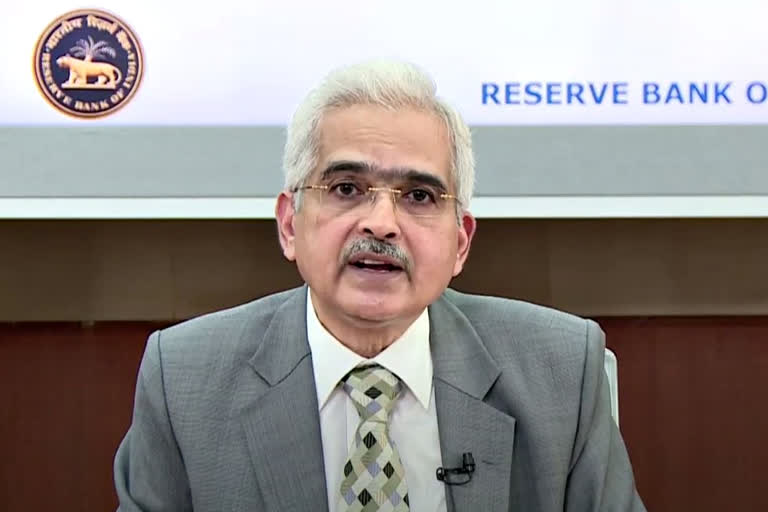Mumbai: India's economy is showing signs of getting back to normalcy, Reserve Bank of India Governor Shaktikanta Das said on Saturday.
"The Indian economy has started showing signs of getting back to normalcy in response to the staggered easing of restrictions. It is, however, still uncertain when supply chains will be restored fully; how long will it t ake for demand conditions to normalise; and what kind of durable effects the pandemic will leave behind on our potential growth," Das said while addressing the the 7th SBI Banking and Economics Conclave.
Prime Minister Narendra Modi on Thursday expressed similar sentiment and said the domestic economy has started seeing "green shoots" of recovery.
"Indians have the spirit to achieve what is believed to be impossible. No wonder that in India, we are already seeing green shoots when it comes to economic recovery," Modi said while addressing the India Global Week 2020.
Read more:Room for more fiscal support in India in near term given severity of economic situation: IMF
Here are the key points from RBI Governor's address:
- The outbreak of COVID-19 pandemic is unambiguously the worst health and economic crisis in the last 100 years during peace time with unprecedented negative consequences for output, jobs and well-being.
- COVID-19 has dented the existing world order, global value chains, labour and capital movements across globe and needless to say, the socio-economic conditions of large section of world population.
- The COVID-19 pandemic, perhaps, represents so-far the biggest test of the robustness and resilience of our economic and financial system.
- Monetary policy was already in an accommodative mode before the outbreak of COVID-19, with a cumulative repo rate cut of 135 basis points between February 2019 and the onset of the pandemic.
- The MPC decided to cumulatively cut the policy repo rate by 115 basis points over two MPC meetings (first in March and then again in May 2020), resulting in a total policy rate reduction of 250 basis points since February 2019.
- The liquidity measures announced by the RBI since February 2020 aggregate to about Rs 9.57 lakh crore (equivalent to about 4.7 per cent of 2019-20 nominal GDP).
- For the five years between 2015-16 and 2019-20, the Government had infused a total of Rs 3.08 lakh crore in public sector banks (PSBs). As a result of the efforts by both the Reserve Bank and the Government, the overhang of stressed assets in the banking system had declined and capital position had improved.
- As a fulcrum of the calibrated supervisory approach, the Reserve Bank has strengthened its off-site surveillance mechanism to identity emerging risks and assess the vulnerabilities across the supervised entities for timely action.
- With regard to the Punjab & Maharashtra Co-operative Bank, the Reserve Bank is engaged with all stakeholders to find out a workable solution, as losses are very high, eroding deposits by more than 50 per cent.
- The amendment to the Reserve Bank of India Act, 1934 effective from August 1, 2019 has strengthened the ability of Reserve Bank to better regulate and supervise the NBFCs.
- An early warning system with a stress-testing framework has been formed for timely recognition of weak banks for appropriate action. Formation of an ‘umbrella organization’, has been approved to provide liquidity, capital, IT and capacity building support to UCBs.
- As the lock-down has obstructed on-site supervisory examination to an extent, we are further enhancing our off-site surveillance mechanism. The objective of the off-site surveillance system would be to ‘smell the distress’, if any, and be able to initiate pre-emptive actions.
- Policy action in medium-term would require a careful assessment of how the crisis unfolds. Building buffers and raising capital will be crucial not only to ensure credit flows but also to build resilience in the financial system.
- The country's banking and financial system is capable of rising to the occasion in meeting this challenge.In these challenging times, banks have to improve their governance and sharpen their risk management. Banks will also have to raise capital in an anticipatory basis instead of waiting for a situation to arise.
- The economic impact of the pandemic - due to lock-down and anticipated post lock-down compression in economic growth - may result in higher non-performing assets and capital erosion of banks. A recapitalisation plan for PSBs and private banks (PVBs) has, therefore, become necessary.
- The approach to risk management in banks should be in tune with the realisation of more frequent, varied and bigger risk events than in the past.
- The supervisory approach of the Reserve Bank is to further strengthen its focus on developing financial institutions’ ability to identify, measure, and mitigate the risks.
- The new supervisory approach will be two-pronged - first, strengthening the internal defenses of the supervised entities; and second, greater focus on identifying the early warning signals and initiate corrective action.
- To strengthen the internal defenses of the banks, higher emphasis is now being given on causes of weaknesses than on symptoms.
- The Reserve Bank has released a discussion paper on “Governance in Commercial Banks in India” with the objective to align the current regulatory framework with global best practices while being mindful of the context of the domestic financial system. The Reserve Bank will extend these principles of good governance to large-sized NBFCs in due course.
- Despite the substantial impact of pandemic in our daily lives, the financial system of the country, including all the payment systems and financial markets, are functioning without any hindrance.
- The need of the hour is to restore confidence, preserve financial stability, revive growth and recover stronger.
- Post containment of COVID-19, a very careful trajectory has to be followed in orderly unwinding of counter-cyclical regulatory measures and the financial sector should return to normal functioning without relying on the regulatory relaxations as the new norm.
(With inputs from agencies)



